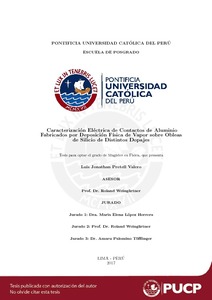| dc.contributor.advisor | Weingärtner, Roland | |
| dc.contributor.author | Pretell Valero, Luis Jonathan | es_ES |
| dc.date.accessioned | 2017-05-25T23:02:31Z | es_ES |
| dc.date.available | 2017-05-25T23:02:31Z | es_ES |
| dc.date.created | 2017 | es_ES |
| dc.date.issued | 2017-05-25 | es_ES |
| dc.identifier.uri | http://hdl.handle.net/20.500.12404/8687 | |
| dc.description.abstract | Los dispositivos electrónicos formados por semiconductores se encuentran conectados con otros terminales externos por medio de contactos metálicos, los cuales forman las conexiones dentro de los circuitos integrados. A través de estos contactos es por donde el flujo de portadores de carga entra y sale de un dispositivo a otro, al aplicarles una diferencia de potencial. Los contactos pueden ser: Schottky, aquellos que conducen carga en un sentido a baja resistencia y en el otro sentido ofrecen más alta resistencia, u óhmicos, los cuales ofrecen una baja resistencia al paso de la corriente en ambos sentidos.
Es de interés obtener contactos óhmicos a partir de contactos Schottky por medio de tratamientos térmicos. Los contactos Schottky resultaron al evaporar aluminio sobre muestras de silicio de distintos dopajes, los cuales se fabricaron por Deposición Física de Vapor. Para analizar el proceso de formación de contacto óhmico en las muestras, estas se caracterizaron electrónicamente por medio de las curvas densidad de corriente vs. voltaje (J-V ), antes y después de los tratamientos térmicos, para las temperaturas de 500_C, 550_C y 600_C cada una por 10 min.
Los contactos Schottky obtenidos en las muestras de silicio tipo p, con un tratamiento térmico a 500_C, se comportaron como contacto óhmico. Para los siguientes tratamientos térmicos (550_C y 600_C), la resistencia de contacto aumenta, debido a que en la interfaz silicio-aluminio se forma una región cargada p+, la cual frenará la conducción por emisión térmica. Se observa también que, a mayor dopaje en las muestras, la resistencia de contacto es menor, ya que el transporte por tunelaje a través de la barrera comienza a dominar.
Los contactos Schottky obtenidos en las muestras de silicio tipo n, con un tratamiento térmico a 500_C, mejora la conducción en las muestras de bajo dopaje, mientras que en la de alto dopaje la resistencia aumenta. Esto debido a la capa p+ que se forma en la interfaz del silicio-aluminio y, con los siguientes tratamientos térmicos (550_C y 600_C), la región p+ crece. Las resistencias de contacto aumentan en la muestra de bajo dopaje, en las de medio dopaje desaparece la barrera Schottky, y en la muestra de alto dopaje la región de carga espacial sufre una inversión, formándose un contacto Schottky de silicio tipo p. | es_ES |
| dc.description.abstract | Semiconductor electronic devices are connected to other external terminals by means of metal contacts. These form interconnections of devices within the integrated circuits. Through these contacts is where the flow of charge carriers enters and leaves from one device to another, by the potential difference that is applied.
Contacts could be: Schottky, those that conduct charge in one direction and in the other offer resistance, or ohmic contact, which offer low resistance to the current ow in both directions.
It is of interest to obtain ohmic contacts, from Schottky contacts through annealing.
Schottky contacts were obtained by the evaporation of aluminum on different dopal silicon samples, which were made by Physical Vapor Deposition. To analyze the ohmic contact formation process in the samples, these were characterized electronically by means of the current density vs. voltage curves (J-V ), before and after annealing, at temperatures of 500_C , 550_C y 600_C for 10 minutes each Schottky contacts obtained in the p-type silicon samples, with annealing at 500_C, behaved as ohmic contact. For the following annealing temperatures (550_C y 600_C) the contact resistance increases, because a p+ region is formed at the silicon-aluminum interface, which could slow the conduction by thermal emission. It is also observed that, at higher doping concentration in the samples, the contact resistance decreases, since the tunneling transport through the barrier begins to dominate.
Schottky contacts obtained in the n-type silicon samples, with annealing at 500_C, improve the conduction in the samples with low doping concentration, while
in the the samples with of high doping concentration, the resistance increases. This
is because a p+ layer is formed at the silicon-alumininum interface, and with the
following annealing temperatures (550_C y 600_C), the p+ region continues growing.
The contact resistances increase in the low doping concentration, in the medium doping
concentration sample, the Schottky barrier disappears, and in the high doping
concentration sample the space charge region changes to an inversion, it will now
form a Schottky p-type silicon contact. | es_ES |
| dc.language.iso | spa | es_ES |
| dc.publisher | Pontificia Universidad Católica del Perú | es_ES |
| dc.rights | Atribución-NoComercial-SinDerivadas 2.5 Perú | * |
| dc.rights | info:eu-repo/semantics/openAccess | es_ES |
| dc.rights.uri | http://creativecommons.org/licenses/by-nc-nd/2.5/pe/ | * |
| dc.subject | Semiconductores | es_ES |
| dc.subject | Silicio | es_ES |
| dc.title | Caracterización eléctrica de contactos de aluminio fabricados por deposición física de vapor sobre obleas de Silicio de distintos dopajes | es_ES |
| dc.type | info:eu-repo/semantics/masterThesis | es_ES |
| thesis.degree.name | Magíster en Física | es_ES |
| thesis.degree.level | Maestría | es_ES |
| thesis.degree.grantor | Pontificia Universidad Católica del Perú. Escuela de Posgrado | es_ES |
| thesis.degree.discipline | Física | es_ES |
| renati.discipline | 533017 | es_ES |
| renati.level | https://purl.org/pe-repo/renati/level#maestro | es_ES |
| renati.type | http://purl.org/pe-repo/renati/type#tesis | es_ES |
| dc.publisher.country | PE | es_ES |
| dc.subject.ocde | https://purl.org/pe-repo/ocde/ford#1.03.00 | es_ES |






